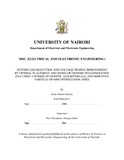Loss reduction and voltage profile improvement by optimal placement and sizing of distributed generation (DG) using a hybrid of genetic algorithm (GA) and improved particle swarm optimization (IPSO)
Abstract
Though several algorithms for optimizing DG location and size in a power system network with
the aim of reducing system power losses and improving voltage profile have already been
proposed, they still suffer from several drawbacks. As a result much can be done in coming up
with new algorithms or improving the already existing ones so as to address this important issue
more efficiently and effectively. Majority of the proposed algorithms have emphasized on real
power losses only in their formulations. They have ignored the reactive power losses which are
key in the operation of power systems. In modern practical power systems reactive power
injection plays a critical role in voltage stability control, thus the reactive power losses need to be
incorporated in optimizing DG allocation for voltage profile improvement. The results of the few
works which have considered reactive power losses in their optimization can be improved by
using more recent and accurate algorithms. This research work aimed at solving this problem by
proposing a hybrid of GA and IPSO to optimize DG location and size while considering both
real and reactive power losses. Both real and reactive power flow and power loss sensitivity
factors were utilized in identifying the candidate buses for DG allocation. This reduced the
search space for the algorithm and thus increased its rate of convergence. The suggested method
was programmed under MATLAB 2011 software and tested using IEEE 30-bus test system,
IEEE 33-bus test system and IEEE 57-bus test system by considering three types of DGs. The
results obtained were compared to those obtained by other researchers. It was observed that GAIPSO
method performed better in terms of reducing both real and reactive power losses as
compared to Heuristic, GA, PSO and IPSO methods. For the IEEE 30-bus test system, the
percentage reduction in real power loss was 35.46%, 35.82% and 35.21% while the percentage
reduction in reactive power loss was 36.01%, 35.95% and 35.88% for type 1, type 2 and type 3
DGs respectively. The voltage profile of the networks after optimizing DG locations and sizes
using GA-IPSO method were also found to be much improved with the lowest bus voltage
improved to 1.01pu and 0.959pu for the IEEE 30-bus and 33-bus test systems respectively. The
effects of DG penetration on system power losses and voltage profiles were studied. The system
power losses reduced with the introduction of DGs in the network up to an optimal number
where any further DG inclusion resulted to an increase in system power losses and deviation of
bus voltages outside acceptable limits.
Publisher
University of Nairobi

